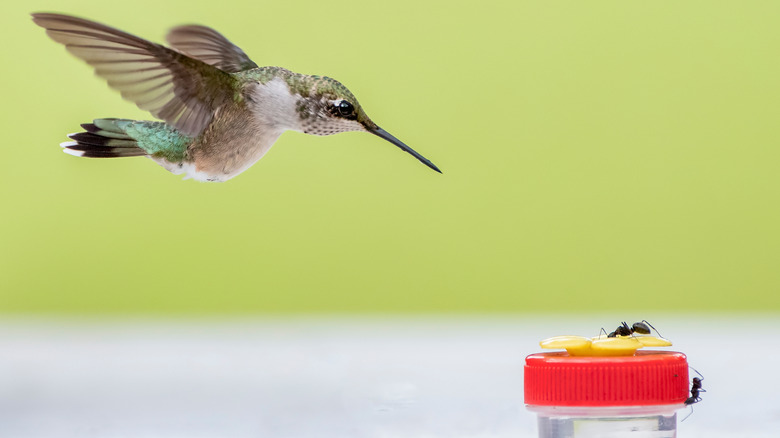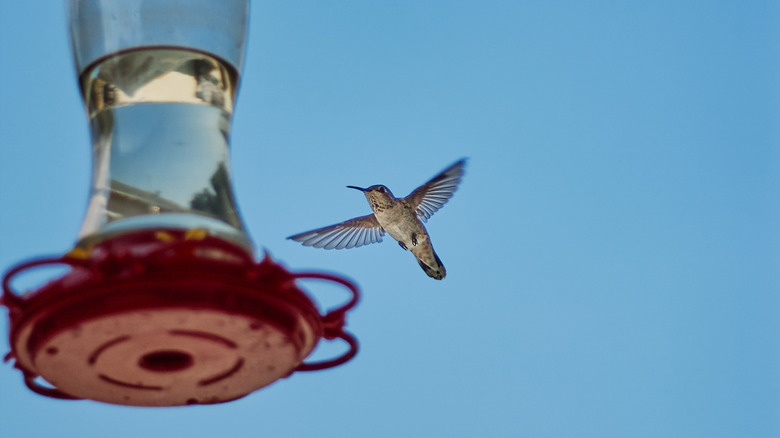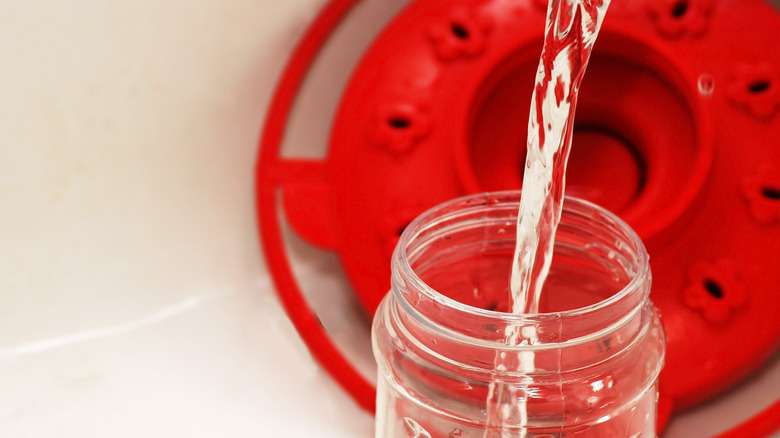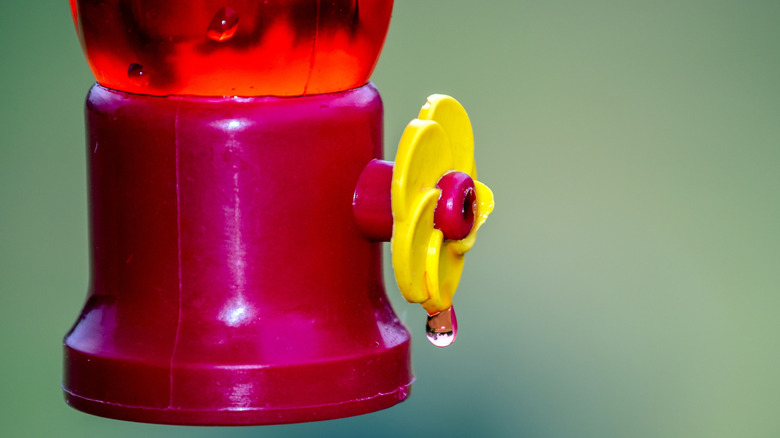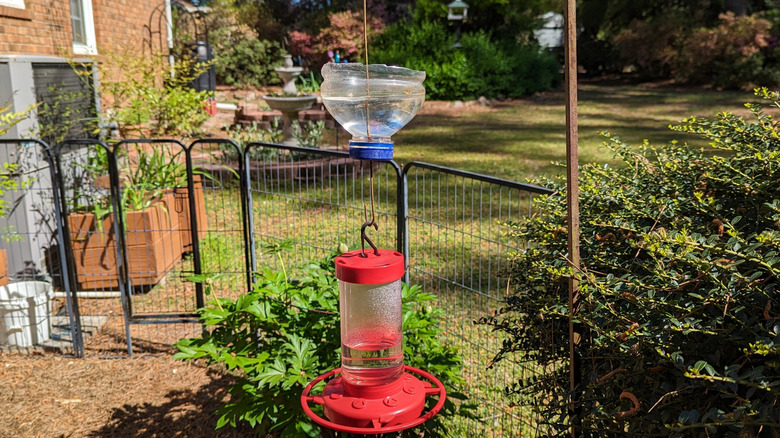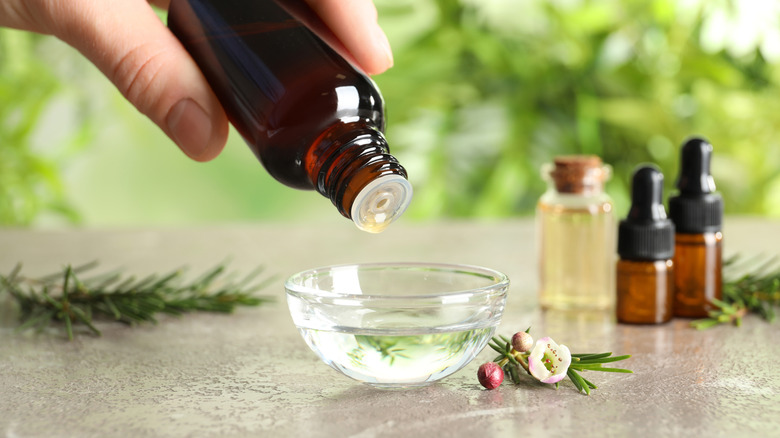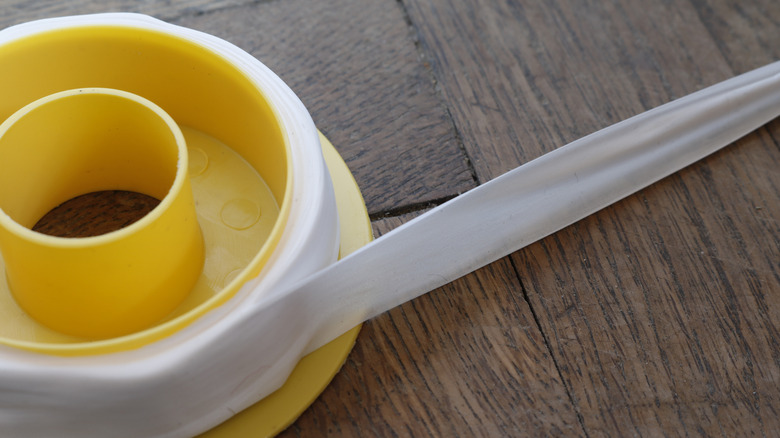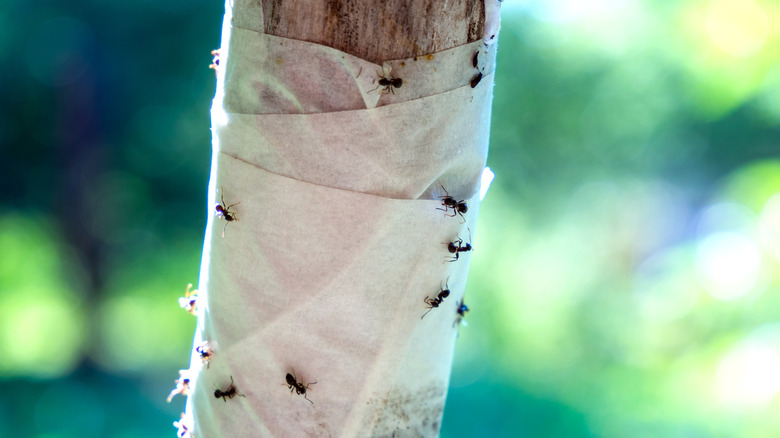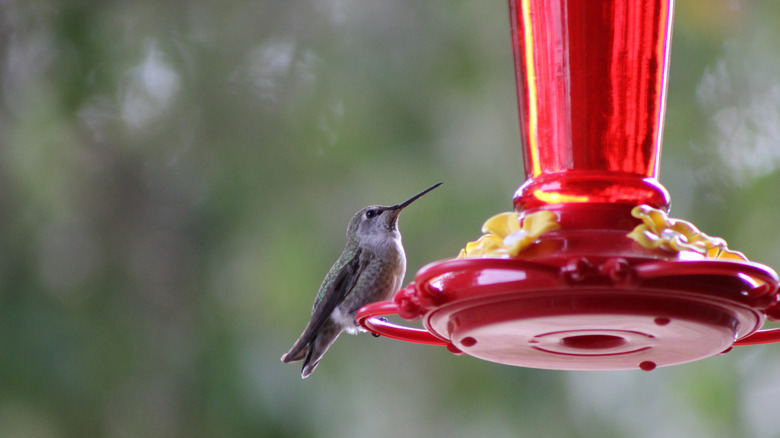9 Clever Tips To Keep Pesky Ants Out Of Your Hummingbird Feeders
We may receive a commission on purchases made from links.
Hanging up a few hummingbird feeders and watching the hummers zip in and out is one of life's simple pleasures that never gets old. Unfortunately, hummingbirds aren't the only ones who are drawn in by the sweet nectar. Like hummingbirds, ants thrive on sugar and use it to fuel their little bodies with energy. If one or two ants locate the source of the sweet liquid, they leave behind a pheromone trail to alert the rest of the colony and guide them to the meal. While ants don't pose a direct threat to the birds, they can quickly take over the feeder, clog up the feeding ports, and even contaminate the nectar. Not only does this make the nectar unappealing to the hummingbirds, but it could potentially make them sick if they do sip from it.
Luckily, there are several ways to evict ants from your hummingbird stations, but it's important to find a solution that doesn't put our feathered friends at risk. First and foremost, avoid any harsh chemicals, as using pesticides is a mistake that could be chasing hummingbirds away from your yard. Even if a product is marketed as an insecticide, it often affects more than just unwanted insects and can end up harming pollinators, other birds, and even pets. Greasing up poles or hooks with oil is another method that can harm hummingbirds. If a bird gets oil onto their feathers, it can affect their ability to fly or preen, both of which are necessary for their survival. Fortunately, there are plenty of safe, effective ant-repelling methods, like the ones outlined below.
Place the feeder in an area that's harder for ants to get to
There are a few factors to consider when determining the best place to put your hummingbird feeder, especially if you want to keep ants and other pests away. First, you don't want to make it easy for ants to discover the nectar; even a few drops of sugar water landing on a nearby branch or railing can help guide ants to the source. Second, putting your hummingbird feeder in the wrong spot, like near climbable surfaces, increases the chance that a forager will get to it. Unfortunately, once one ant finds a clear path to what it deems high-quality food, it'll leave a strong pheromone trail to encourage the colony to join. If they don't have easy access, it's less likely that a scouting ant will stumble onto the feeder to begin with.
To make it more challenging for ants to reach your feeder, avoid setting it directly on a table, plant stand, deck railing, and other surfaces they can easily climb up. You'll also want to place it in an open area that's away from walls, tree trunks, fencing, railings, and anything else that gives them an easy path. When hanging your feeder from a tree branch, choose one that's more out in the open and away from dense limbs. Placing feeders in open areas can also limit drips onto lower-level objects, making it less likely that ants will catch a whiff of the sugary scent and locate the source.
Clean the area regularly to eliminate the ants' scent trails
Keeping your feeder clean doesn't just protect the hummingbirds; it's also one of the easiest ways to keep ants from returning. Two of the most common mistakes everyone makes when cleaning hummingbird feeders are not washing them often enough and overlooking the surrounding area. Nectar can drip onto nearby branches or build up on poles or other surfaces over time, helping to guide ants to the feeder. However, it's not just about cleaning up a sticky mess, but also about eliminating the ants' scent trails. Even if you've just seen one ant make its way to your hummingbird station, there's a good chance it's already left a trail of pheromones for the others to follow.
Because spoiled sugar water can attract both ants and bacteria, it's important to stay on top of keeping the sugar water fresh and the feeders clean. Although you can get away with cleaning them twice per week in cooler weather, hummingbird feeders need a good scrubbing as often as every day during the hot summer months. Use hot water and hydrogen peroxide, vinegar, or bleach to remove old nectar and sticky residue from the feeder. Don't forget to clean the pole and any nearby surfaces, especially if you've noticed ants around. Cleaning the area doesn't just help keep your hummingbirds safe and healthy, but it scrubs away those scent trails, making it harder for ants to find their way back.
Keep the feeder from leaking to prevent ants from finding it
If ants keep showing up, there's a chance your hummingbird feeder is leaking. A worn-out seal is one of the most common reasons an otherwise good feeder starts to leak, especially if you've had it for a few years. Glass or plastic models can also develop small cracks that let water seep out in places you may not have noticed. Even if there's no damage, sometimes the weather can cause leakage. In hot summer months, the nectar can expand and push on the seal, forcing some of the liquid to drip out of the ports. It's also possible that wind, or even an animal, is causing the feeder to sway and spill as it tips.
Start by checking the ports and reservoirs for signs of leakage. If the seal is broken, you may be able to order a replacement by contacting the manufacturer. Otherwise, it's best to purchase a new, leak-proof model. One of the best options is a saucer feeder, like Feed Garden's Leak-Proof Hummingbird feeder, which has upward-facing ports that make it far less prone to leaking. If hot temperatures are to blame, try moving your hummingbird station to a shadier area of the garden. Keeping it out of direct sunlight helps reduce pressure buildup, and as a bonus, the sugar water won't spoil as fast. You should also make sure the feeder is out of reach of squirrels and other animals that might tip it.
Hang your feeders with fishing line to keep ants from accessing them
Ants can seem to defy the laws of gravity, climbing tall poles and clinging to inverted walls with ease. However, they do have some limits, and you may even already have one of their biggest obstacles sitting in your garage. Surprisingly, hanging your hummingbird feeders with inexpensive fishing line is an easy way to prevent ants from getting to the nectar. This thin, slick material makes it nearly impossible for ants to get a solid grip as they try to climb. If they attempt to make the descent, they're likely to either slip off or give up in search of an easier meal.
If you want to give fishing line a try, look for a high-test option that's rated for the weight of your hummingbird feeder (such as this Stren Original Monofilament Fishing Line, that has a break strength of 4 pounds) especially if yours holds a lot of sugar water. Measure the chain or rope that you were previously using and cut a piece of fishing line that's slightly longer, leaving room to tie it to the hook and feeder. Then, all you have to do is tie it in place and hang it up. This method works best if your hummingbird station is in an open area that doesn't provide ants with an alternative path to the feeder.
Install a moat to create a water barrier
One of the most tried-and-true methods of keeping ants out of hummingbird feeders is installing an ant moat. These small, cup-like barriers hang between the hook and the feeder, creating an impassable blockage. Once you fill the moat with water, any ants that march down the rope or chain will be met with a dead end. Most ants can't swim, so more often than not, they'll turn around once they see the obstacle. If they do attempt to push forward, they may drown before they even get near the nectar. Even if a very lucky ant somehow manages to survive and get across, the moat will make the feeder a non-viable food source for the colony.
Because ants are a recurring issue for hummingbird lovers, many nectar feeders come with a built-in ant moat. If yours doesn't have one, you can also buy them separately, and they're usually simple to add to your existing setup. Alternatively, you can easily make a DIY ant moat using an empty soda bottle. To create your own, start by cutting off the top part of a plastic bottle so you're working with a small bowl shape. Drill a small hole into the cap, and thread a long piece of wire through it. Use a hot glue gun to secure the wire in place, then bend the ends into hooks that will attach to the feeder and pole. Fill the reservoir with water, and you're all set.
Use essential oils to naturally repel ants
Ants have an impressive sense of smell, with roughly 400 odor receptors, they have several times more than most insects. While this helps them communicate and locate food, it also gives us a way to deter ants with an easy essential oil hack. Essential oils contain strong-scented compounds, which can throw off an ant's senses. In fact, thyme oil and its active compound, thymol, are already used in organic pesticides to target ants. Additionally, a 2021 study published in Instars: A Journal of Student Research found that tea tree oil deterred red imported fire ants from accessing the Oreo bait 100% of the time.
To repel ants by overwhelming their senses, you can try making a diluted spray by adding 10 drops of essential oils for each cup of water. You can also add a bit of dish soap to help it stick better. The 2021 study used pure essential oils, without diluting them, so feel free to experiment and make your mix a little stronger. Apply the solution directly to the ground where ants are likely to travel from. To keep hummingbirds safe, never add essential oils or mixtures to the feeder pole, hangers, or anywhere birds might perch or brush against. Hummingbirds can't walk or hop on the ground like most birds can, so there's less of a risk of them coming into contact with the oils in this area. Alternatively, add the oil to a dish covered with wire mesh, and set it near the feeder. This allows the scent to repel ants while preventing birds from touching the oil.
Use Teflon tape to make surfaces hard for ants to grip
Although it has the word tape in its name, Teflon tape is the opposite of sticky. It's actually a slick material commonly used in plumbing to wrap around pipe threads and fill in small gaps to prevent leaks. Surprisingly, it may also be the solution to your ant problem. Made from polytetrafluoroethylene (PTFE), the same material used in many non-stick pans, it creates a slippery surface that ants can't easily grip, making it harder for them to climb poles or reach your feeder. Because there aren't any adhesives, it's safe to use around hummingbirds.
To make your feeder poles harder for ants to scale, wrap a few inches of Teflon tape around the base. Ants will either slip right off or give up and search for easier food elsewhere. You'll need to check the tape periodically to make sure it's still working effectively. After heavy rain or extended humidity, you may need to replace it with fresh tape. As a bonus, you can also use this material for its original purpose. Wrap it around the threads where the reservoir connects to help prevent nectar leaks from your feeder.
Create a sticky barrier to stop ants in their tracks
Just like slick surfaces help keep ants away, sticky materials also serve a purpose. Some adhesive barrier traps, like Tanglefoot Tangle-Trap Sticky Coating, come in a gel-like form that you brush on feeder poles to create an ultra-sticky surface that ants can't walk through. While double-sided tape works well short term, it doesn't hold up well against moisture, dust, and dirt. That said, tape is typically cheaper, less messy, and easier to remove when you're ready to switch it out.
Whether you choose tape, sticky gel, or another adhesive ant trap, it's critical to keep the hummingbirds' safety in mind and implement measures to prevent them coming into contact with the substance. Similar to oils, if a sticky substance gets on a bird's feathers, it can be detrimental to them. They may struggle to fly or regulate their body temperature. Avoid applying anything sticky or gummy to parts of poles or feeders where hummingbirds or other small animals could come into contact with it. To make it as safe as possible for hummingbirds and other creatures, attach a protective cover, like a PVC pipe, over the sticky area. Not only will this keep birds from accidentally coming into contact with it, but it can also shield the adhesive layer from dirt and debris.
Relocate the feeder to confuse ants
If your hummingbirds have been sharing their feeder with pesky ants for a while now, it may be a good idea to relocate it. As you now know, ants leave behind pheromone trails to alert others and mark their food sources. By moving the feeder a few feet away, their scent path will now lead to nothing, forcing them to start their search from scratch. On the other hand, hummingbirds rely on sight rather than smell, so they'll be able to easily find the new spot, even if the ants can't.
Move your feeder a few feet away from its original location, making sure it's still in an area that's visible to hummingbirds but breaks the ant trail. Although moving the feeder will slow the ants down, you may still have issues if you aren't combining this trick with other methods. After relocating the feeder, clean the old area thoroughly to remove any lingering scent trails. Once rehung, install an ant moat or other barrier so that even if the ants catch up, they're blocked from reaching the nectar.
